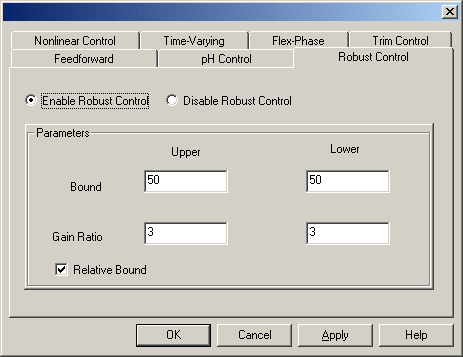Robust MFA Controller
In complex control applications, the following challenges
may occur. (1) There is a big change in the process
dynamics so that a prompt control action is required
to meet the control performance criteria; (2) The dominant
disturbance cannot be economically measured so that
feedforward compensation cannot be easily implemented;
(3) A controller purposely de-tuned to minimize the
variations in its manipulated variable may lose control
when there is a large disturbance or significant dynamic
behavior change; or (4) Changes in dynamic behavior
or load do not provide triggering information to allow
the control system to switch operating modes.
For instance, controlling the reaction temperature for
a batch reactor is always a challenge due to the complex
nature of the process, large potential disturbances,
interactions between key variables, and multiple operating
conditions. A large percentage of batch reactors running
today cannot keep the reactor temperature in automatic
control throughout the entire operating period thus
resulting in lower efficiency, wasted manpower and materials,
and inconsistent product quality.
An exothermal batch reactor process typically has 4
operating stages: (1) Startup Stage: ramps up the reactor
temperature by use of steam to a pre-defined reaction
temperature; (2) Reaction and Holding Stage: holds the
temperature by use of cooling water while chemical reaction
is taking place and heat is being generated; (3) No-reaction
and Holding Stage: holds the temperature by use of steam
after main chemical reaction is complete and heat is
not being generated; and (4) Ending Stage: ramps down
the reactor temperature for discharging the products.
During the transition period from Stage 2 to Stage 3,
the reactor can change its nature rapidly from a heat-generation
process to a heat-consumption process. This change happens
without any triggering signal because the chemical reaction
can end at any time depending on the types of chemicals,
their concentration, catalyst, and reaction temperature.
Within a very short period of time, the reactor temperature
can drop significantly. The control system must react
quickly to cut-off the cooling water and inject a proper
amount of steam to drive the reactor temperature back
to normal. A regular feedback controller is not able
to automatically control a batch reactor during this
transition. In practice, batch reactors are usually
switched to manual control and rely on well-trained
operators during critical transitions. It is a tedious
and nerve-wracking job that can result in low product
quality and yield.
The Robust MFA controller is able to control the problematic
processes described. There is no need to re-design the
controller, use feedforward compensation, or re-tune
the controller parameters. The Robust MFA controller
is able to keep the system in automatic control through
normal and extreme operating conditions when there are
significant disturbances or process dynamic changes.
Robust MFA Controller Configuration
As shown in the following graph, the Robust MFA controller
can be configured with these parameters.

Robust MFA controller configuration menu
(1) Upper and Lower Bound - The bounds for process
variable (PV) being controlled. These are "intelligent"
upper and lower boundaries that are typically the marginal
values the PV should not exceed. PV is unlike controller
output (OP) where a hard limit or constraint can be
set. PV is a process variable that can only be varied
by manipulating the OP. Thus, the Upper and Lower Bounds
for PV are very different from the OP constraints. (2)
Gain Ratio - The coefficient to increase or decrease
the MFA control action based on the PV. For instance,
a Gain Ratio of 3 is the default setting. As PV gets
closer to reaching its bounds, MFA will react like it
has a gain that is 3 times higher than its setting.
Notice that this is not a gain scheduling approach,
although it appears to be. Gain scheduling will not
be able to resolve the complex problems described.
|